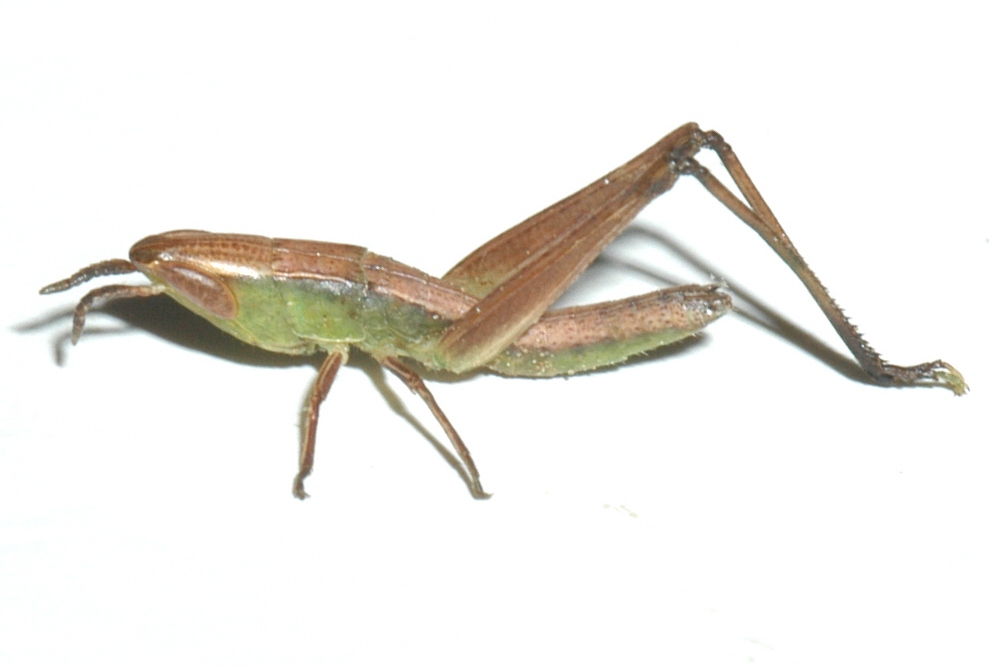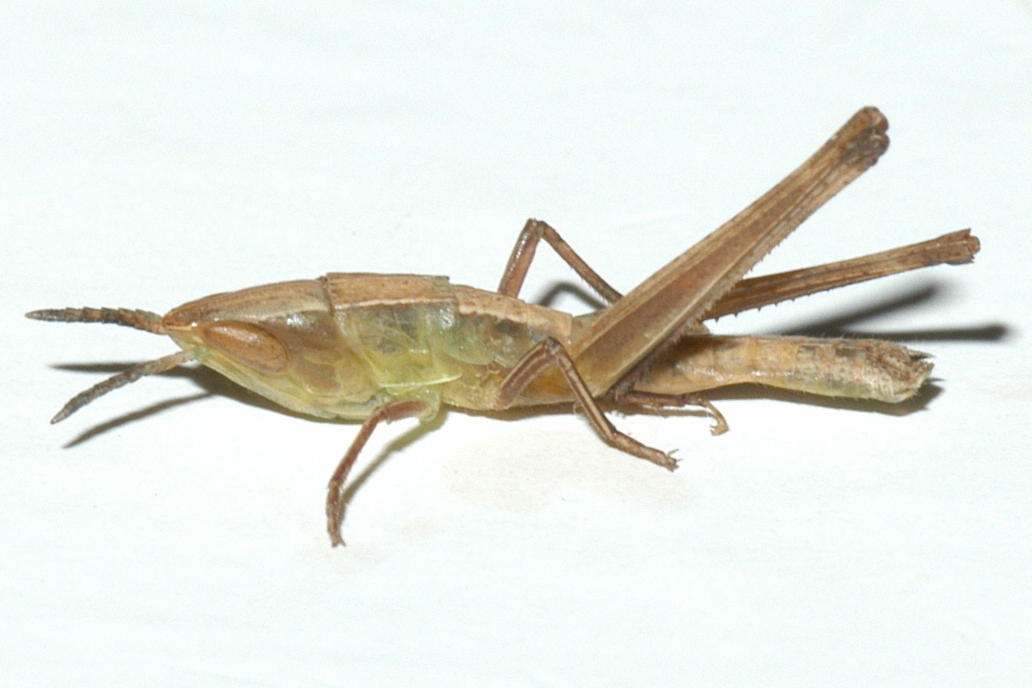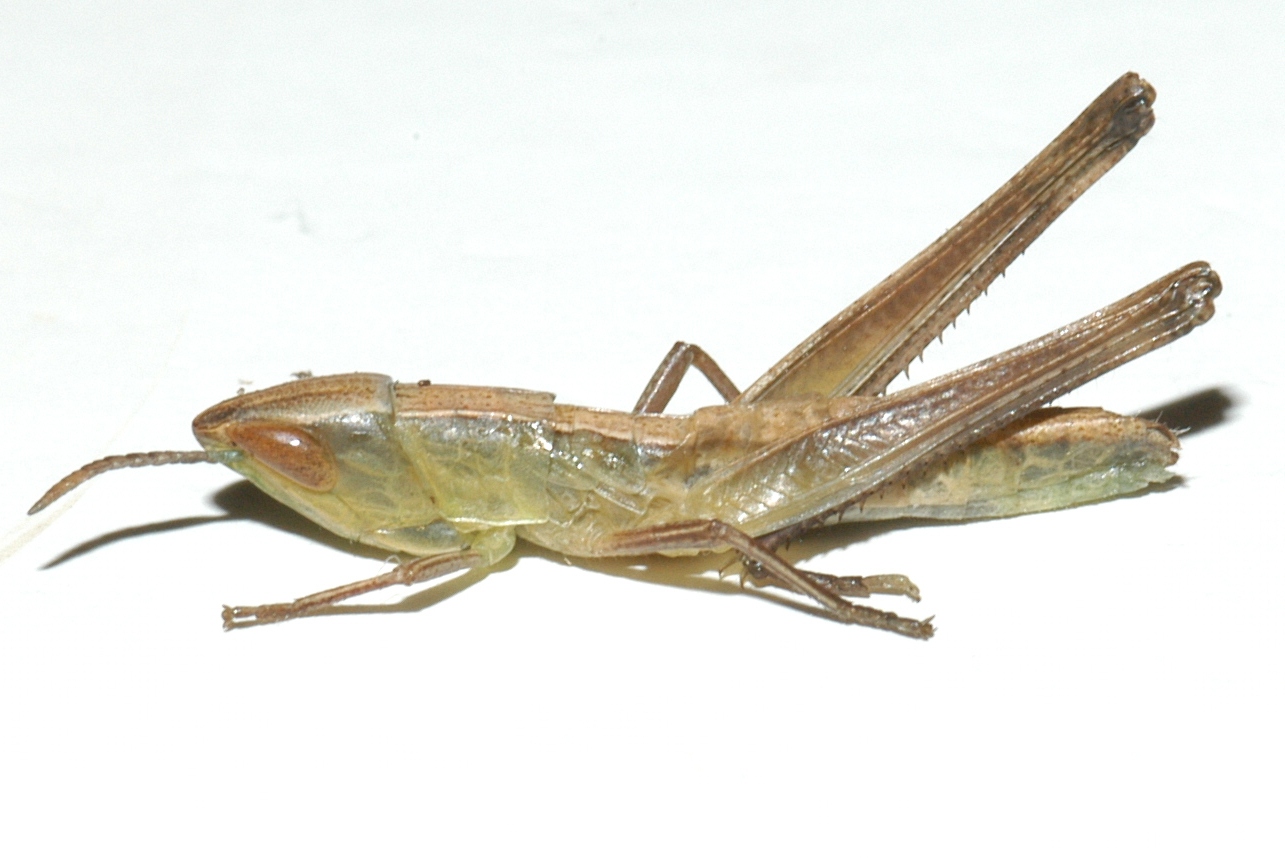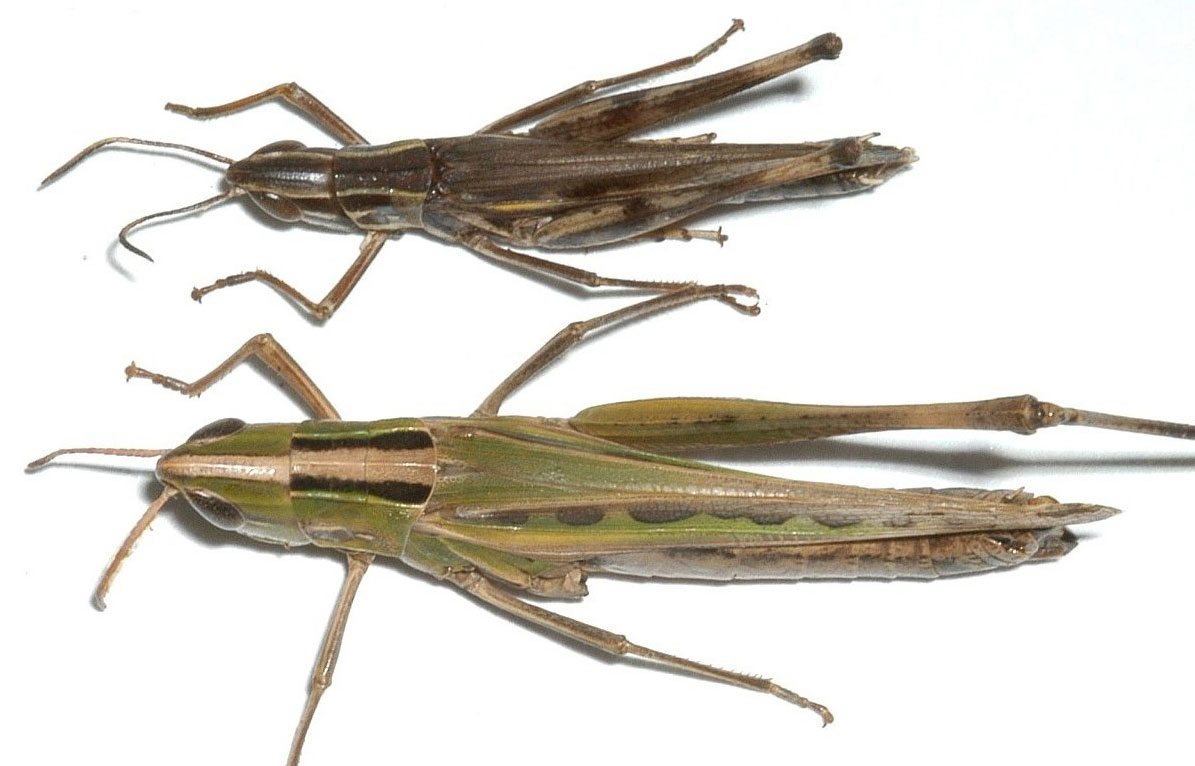Syrbula admirabilis
|
Geographic range of Syrbula admirabilis (Uhler) |
|
Fig. 1, first instar: BL 6-9 mm, FL 3.5-6 mm |
|
Fig. 2, second instar:BL 8-11 mm, FL 4-7 mm, AS 12-15 |
|
Fig. 3, third instar:BL 10-19 mm, FL 6-11 mm, AS 13-17 |
|
Fig. 4, fourth instar: BL 15-24 mm, FL 9-15 mm, AS 17-20 |
|
Fig. 5, fifth instar: BL 20-30 mm, FL 11-19 mm, AS 19-22 |
|
Fig. 6, adult male: BL 21-30 mm, FL 17-20 mm, AS 21-26 |
|
Fig. 7, adult female: BL 33-40 mm, FL 20-26 mm, AS 23-26 |
|
Fig. 8, dorsal view of admirable grasshopper |
Species
Admirable grasshopper
Syrbula admirabilis (Uhler)
Subfamily Gomphocerinae
Identification
The adult male and female differ strongly in size and appearance. Both sexes are very slender and agile. The abdomen is pale brownish in the female and interspersed with darker brown patches in the male. Females are much larger than males and are usually greenish in color with a series of three to seven dark brown blotches on the tegmina. In the male these blotches may appear as distinct spots while in the female the tegmen appears crenulated. The pronotum is greenish with a brownish patch and pair of whitish marks on the sides, as well as a whitish line along the lateral carina, edged on the inner side with black, and with a pale brownish band running the length of the middle. The pale brown band continues onto the dorsal surface of the head, where it is more thinly edged in black. Occasionally females may have the green replaced by pale brownish. The male is normally dark brown with a pale streak along the front of the tegmina near the base, and with the dark blotches somewhat blackish or poorly discernible. The pronotum is whitish along the lower margins with this band extending upward along the front edge and becoming contiguous with a white mark just below the height of the eye, and another white mark behind. A whitish line runs the length of the laternal carina and onto the head. The dorsal surfaces of the head and pronotum of the male are dark brown and lack the pale brown band evident in females. The hind femur of the female is usually unmarked green on the outer surface, but often with some dark suffusion along the dorsal edge, or more rarely with a series of dark bands. The inner surfaces are dull brown to brownish green. In the brown variety, green will be largely replaced by pale brown. The hind femur of the male is dark brown with whitish along the ventral edge and most often with two diffuse white bands in the middle, and with a pale band distally, contrasting with blackish at the knee. The inner surfaces are brown often with one or two diffuse white patches, generally with a similar pattern to the outer surface. The hind tibiae are pale brown in the female and somewhat darker brown in the male, and the spines are blackish.
The nymphs are identifiable by their shape, structures, and color patterns (Fig. 1-5).
- Head. Compound eyes tan; face strongly slanted; antennae of instars I to IV ensiform, antennae of instar V nearly filiform; head of all instars with green laterally, tan to brown dorsally, brown and tan in instar V of male.
- Lateral carinae of pronotum incised once, colored ivory to light tan, blending with dorsal tan area in instars I to III, edged with blackish in instars IV and V; hind femur greenish basally, brownish distally.
- Abdomen in all instars green vetrally and laterally, tan dorsally.
Distribution and habitat
The admirable grasshopper has a broad distribution across North America. It can be found from Pennsylvania and Florida west to Wisconsin, Iowa, Nebraska, Arizona, and southward through much of Mexico. It occurs in dry uplands with poor soil and scanty vegetation and open areas with knee-high grasses. In Nebraska it is common in a variety of open grassy areas, especially areas that are frequently mowed or hayed.
Economic importance
While the admirable grasshopper can occur at moderate to high densities, its habit of feeding on a variety of grasses and its preference for somewhat disturbed areas suggests it is unlikely to cause damage in rangeland. It could potentially damage hayfields at high densities, but this has not been documented.
Food preferences
This grasshopper feeds on a variety of grasses. Studies in Kansas showed that its diet was restricted to grasses, and that ingestion was generally in proportion to abundance. At least 12 identified grass species were found in the crops of this grasshopper, as well as several undetermined species. Grasses ingested included big bluestem, little bluestem, blue grama, hairy grama, Japanese brome, buffalograss, junegrass, Scribner panicum, Kentucky bluegrass, indiangrass, and tall dropseed.
Dispersal and migration
The dispersal ability of this grasshopper has not been studied in detail. The males are exceptional fliers and the females somewhat less so. Females usually fly about 15 to 40 meters when alarmed, while males fly more variable distances. It likely disperses periodically, but large populations tend to be somewhat localized.
Hatching
This is presumably a late hatching species and nymphs are most common in Nebraska in July. The egg pods of a related species, Syrbula montezuma reportedly contain 45 eggs.
Nymphal development
Nymphs appear in summer and may be locally common in July and August. There are likely five instars.
Adults and reproduction
Adults occur in the same areas in which the nymphs develop. They appear relatively late in the season, with peak numbers in Nebraska from early August until October. The courtship of the admirable grasshopper is reportedly very complex. Males stridulate in the vicinity of females, and vary their courtship with movements of the palps, waving of the antennae, and tipping of the femora as males approach females. Males do not forcefully mount females.
Population ecology
The population ecology of the admirable grasshopper has not been studied, but it likely undergoes some fluctuation in year to year numbers. In Nebraska, it was abundant in 2006 at a few sites where it was only moderately common in 2005.
Daily activity
The daily activity of this grasshopper has not been studied in detail.
Source and date
University of Nebraska Species Fact Sheet March 2007 by Mathew L. Brust
Selected references
Blatchley, W. S. 1920. Orthoptera of Northeastern America, with especial reference to the faunas of Indiana and Florida. The Nature Publishing Company, Indianapolis, Indiana. 784 pp.
Mulkern, G. B., K. P. Pruess, H. Knutson, A. F. Hagen, J. B. Campbell, and J. D. Lambley. 1969. Food habits and preferences of grassland grasshoppers of the north central Great Plains. North Dakota State University Agricultural Experiment Station, North Central Regional Publication no. 196. 32 pp.
Otte, D. 1970. A comparative study of communicative behavior in grasshoppers. Miscellaneous Publications of the University of Michigan Museum of Zoology no. 141: 1-168.
Otte, D. 1972. Simple versus elaborate behavior in grasshoppers. An analysis of communication in the genus Syrbula. Behavior 42: 291-322.
Otte, D. 1981. The North American grasshoppers, Volume I, Acrididae: Gomphocerinae and Acridinae. Harvard University Press, Cambridge, Massachusetts. 368 pp.







